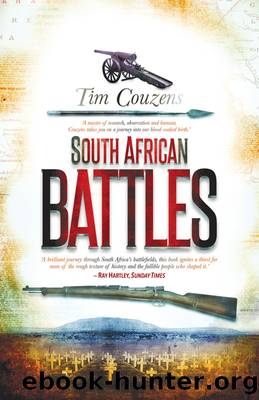South African Battles by Timothy Couzens

Author:Timothy Couzens
Language: eng
Format: epub
Tags: HBW - Military History
Publisher: Jonathan Ball Publishers
Published: 2013-09-18T00:00:00+00:00
The siege at Potchefstroom
(based on a drawing by Gert van den Bergh)
These three strongpoints were to be defended. The parapets of the earthen fort, by no means complete nor impregnable, were hastily heightened and strengthened with mealie sacks and crates of tinned beef from the reserve supply. That evening some 50 citizen refugees from the town sought sanctuary at the fort. These included Chevalier Forssman, his wife, young son and seven daughters (among whom were Emelia Sketchley and Mrs Katherine Palmer), and two teachers, the misses Malan and Wart.
While he could not refuse them, Winsloe was âembarrassed by the presence of ladies and childrenâ. Together with the black transport drivers and the regular soldiers, the inhabitants of the fort eventually reached more than 300. And the structure was no more than 25 yards square!
The landdrostâs office was garrisoned by Captain Falls and 24 soldiers (they were joined by Major Clarke and Raaff and a few of his men, who were scattered in nearby buildings to provide cover fire). Lieutenant Dalrymple-Hay and a detachment of Fusiliers guarded the gaol. But the Boers held the rest of the town (including the Royal Hotel, the Forssman house and Goetzâs residence). There were some British loyalist families in town but the majority of the town residents were firmly in the Boer camp. Cronjéâs first objective was to get the Proclamation of Independence printed by the sympathetic printer (his name was Borrius) in town.
But at 9 oâclock on 16 December (a day of real significance for the Boers as the anniversary of the battle of Blood River in 1838 and the covenant that had been made then), while the British breakfasted in little groups outside the fort, guns to hand, a small party of Boers rode slowly past, about 150 yards away, with their rifles at the âcarryâ. At this the mounted infantry, whose horses were already saddled, were sent to warn them that the Boer patrol was not permitted so close to their own lines.
The Boers turned and rode off at a trot, followed into town by the British. At this the first firing of the war began. If both sides are to be believed, they were not the first to shoot â and therefore no fighting could ever have started! The truth is that it does not really matter â both sides were able and willing to begin the battle. There was only one casualty â the Boer leader of the patrol, Commandant Robbertse, was wounded in the arm â but as historian Ian Bennett has written, this was âa day which arguably changed the course of the history of South Africaâ.
The first shots did unleash a general fight, however. The mounted infantry retired under the protection of the artillery guns, which were now surrounded by a few mealie sacks. The horses were hidden in the fortâs ditch. The Boers poured into the market square, occupying the houses and gardens and directing fire into the landdrostâs office and into the gaol. Their right
Download
This site does not store any files on its server. We only index and link to content provided by other sites. Please contact the content providers to delete copyright contents if any and email us, we'll remove relevant links or contents immediately.
| Africa | Americas |
| Arctic & Antarctica | Asia |
| Australia & Oceania | Europe |
| Middle East | Russia |
| United States | World |
| Ancient Civilizations | Military |
| Historical Study & Educational Resources |
Machine Learning at Scale with H2O by Gregory Keys | David Whiting(4183)
Never by Ken Follett(3793)
Fairy Tale by Stephen King(3220)
The Man Who Died Twice by Richard Osman(2997)
Oathbringer (The Stormlight Archive, Book 3) by Brandon Sanderson(2885)
Will by Will Smith(2793)
Rationality by Steven Pinker(2291)
The Dark Hours by Michael Connelly(2245)
Can't Hurt Me: Master Your Mind and Defy the Odds - Clean Edition by David Goggins(2228)
The Dawn of Everything: A New History of Humanity by David Graeber & David Wengrow(2122)
Friends, Lovers, and the Big Terrible Thing by Matthew Perry(2119)
Principles for Dealing With the Changing World Order: Why Nations Succeed and Fail by Ray Dalio(1974)
HBR's 10 Must Reads 2022 by Harvard Business Review(1777)
A Short History of War by Jeremy Black(1762)
Go Tell the Bees That I Am Gone by Diana Gabaldon(1687)
515945210 by Unknown(1599)
A Game of Thrones (The Illustrated Edition) by George R. R. Martin(1589)
Kingdom of Ash by Maas Sarah J(1527)
443319537 by Unknown(1470)
